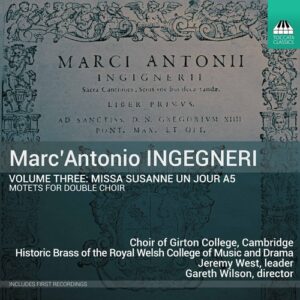Program: #24-03 Air Date: Jan 15, 2024
To listen to this show, you must first LOG IN. If you have already logged in, but you are still seeing this message, please SUBSCRIBE or UPGRADE your subscriber level today.
We continue our series dedicated Monteverdi’s teacher Marc-Antonio Ingegneri and his long-neglected sacred settings with the Choir of Girton College, Cambridge and their director, Gareth Wilson.
NOTE: All of the music on this program comes from recordings on the Toccata Classics label with the Choir of Girton College, Cambridge directed by our guest, Gareth Wilson. Volume 3 is CD # TOCC 0677.
The Cremonese composer Marc’Antonio Ingegneri (c. 1535/36–92) is chiefly remembered as the teacher of Claudio Monteverdi while, for well nigh 500 years, his own achievements were left to sit in the shadows. This third in a series of pioneering recordings from the Choir of Girton College, Cambridge, reveals Ingegneri to have been one of the masters of his age, writing music of breathtaking richness and beauty: the works heard here combine learned, intricate counterpoint with the kind of sheer sonic thrill that brings a shiver of physical excitement. It is, of course, religious music, but it is also extraordinarily passionate, to a degree not previously heard, nor for centuries to come, until the rise of the great Romantic choral works.
Choir of Girton College, Cambridge (1, 2, 4–6, 9–12, 16)
Historic Brass of the Royal Welsh College of Music and Drama (1–7, 9–14)
Jeremy West, leader (3)
Emily Nott, organ (8)
Felix Elliott, organ (15)
Gareth Wilson, director
From MusicWeb International: In the review of Volume 2 of the sacred works of Claudio Monteverdi’s teacher Marc’ Antonio Ingegneri, I wrote that the ‘fresh-voiced choir seems completely devoted to this composer’. This also came across in the Radio 3’s Early Music Show in January 2023, when the interviewed members of the choir and the conductor demonstrated their enthusiasm. They have performed and even toured this music across Europe. One might say that the composer and his music have forged itself into the choir and their director. They sound relaxed, free and passionate, and they confidently bring this music to light for practically the first time in over four centuries. Ingegneri’s language, subtly different from those of his contemporaries, only gradually reveals itself.
To enjoy Missa Susanne un jour fully, one may want first to hear the brass version arranged by Bassani, and then program the five movements contiguously (they sit on tracks 2, 4, 6, 9 and 11). Guillaume Géroult’s distinctly secular text was first set by Didier Lupi (d.c.1560), a little-known figure. In 1560, Orlande de Lassus reworked the chanson – published often over a twenty-year period – and he then composed a mass on it. That set a trend for others to follow.
The chanson became one of the most popular of its time. The upper melodic line is memorable. Much of the harmony is warm and has an air of deep melancholy. The Mass demonstrates these facets throughout, but the chanson is at its clearest in the Kyrie. In the Gloria and Credo, you will detect fragments, especially at cadential points, and certain lines from the original are often imitated across the texture. The overall effect, especially doubled, as it is by brass, is noble and uplifting, particularly in the final Agnus Dei.
Seemingly placed at random are several motets, mostly for double choir, contrasting in mood and, to some extent, in style. The booklet writer Carlos Rodriguez Otero, a Cambridge doctoral student, contrubuted an excellent, detailed essay A Composer between two worlds. He writes of the composer’s ‘pluralistic approach, covering an impressive variety of styles and genre’s’. Those range from a traditional contrapuntal style, as in the Mass, to a more madrigalian approach in the motets O Sacrum convivium and the elegiac Salve Regina.
Director Gareth Wilson supplies another extended essay. We read that ‘the majority of the motets we have recorded come from the 1589 “Liber Sacrarum Contionum” (Book of Sacred Songs) which features most the polychoral items we hear’. To add variety, Exaudiat te Dominus and Regnum mundi are played by brass only; Non mi togli’ Il ben mioand Quel grazia, o qual beltate are performed on the College organ. Even so, the texts of these motets are also included.
At this stage, I am unable to accept Wilson’s belief that Ingegneri’s music is of a ‘staggering high quality’. I have praised the choir, but I would add that even more character and verve is needed in a joyous motet such as Laudate Dominum and indeed Cantate Domino. The words do not always carry clearly because of the acoustic or the accompanying instrumental work.
Wilson is asking if he should continue with Ingegneri – a fourth volume is on the way – or move on to another composer for the educational benefit of his students. There is much of Ingegneri’s music still to be discovered. We will see if it is Girton College that will continue to hold the torch for this fascinating composer.
Gary Higginson
- Cantate Domino a8
- Missa Susanne un jour a5 – Kyrie
Giovanni Bassano (c.1561-1617) after Orlande de Lassus (1532-1594) - Susanne un jour a5 (instrumental)
- Missa Susanne un jour – Gloria
- Laudate Dominum a12
- Missa Susanne un jour – Credo
- Exaudiat te Dominus a9
- Non mi togli’ il ben mio a4
- Missa Susanne un jour – Sanctus and Benedictus
- Omnes sitientes a9
- Missa Susanne un jour – Agnus dei
- O sacrum convivium a6
- Regnum mundi a8
- Qual grazia, o qual beltate a4
- Victimae Paschali laudes a8
- Salve regina a6
Composer Info
Marc-Antonio Ingegneri (c.1535/36–92), Giovanni Bassano (c.1561-1617), Orlande de Lassus (1532-1594)
CD Info
Toccata Classics label CD # TOCC 0677
